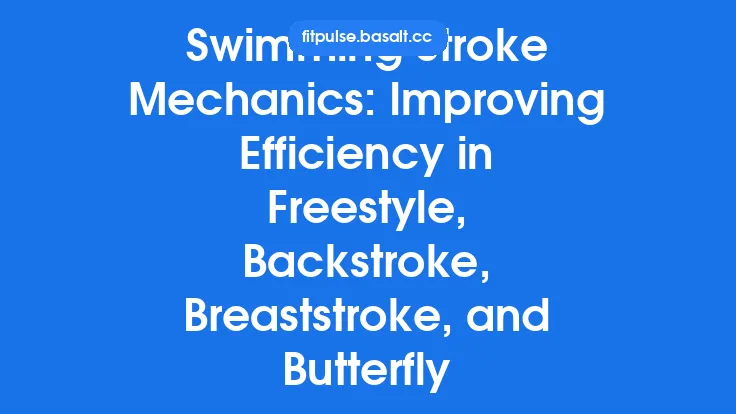Swimming is a low‑impact, full‑body activity that offers cardiovascular, muscular, and joint benefits, yet the repetitive nature of the strokes can predispose athletes to specific overuse injuries. Among the most common complaints are shoulder impingement, knee pain (often termed “swimmer’s knee”), and lower‑back discomfort. Understanding the underlying biomechanics, identifying early warning signs, and implementing a systematic prevention strategy can keep swimmers in the water longer and enhance performance. This article explores the anatomy involved, the typical injury mechanisms, and evidence‑based interventions for shoulder, knee, and lower‑back health, providing a practical roadmap for athletes, coaches, and clinicians alike.
The Shoulder Complex in Swimming: Anatomy, Stressors, and Prevention
1. Anatomical Overview
The shoulder girdle is a highly mobile joint system comprising the glenohumeral joint, the scapulothoracic articulation, the acromioclavicular joint, and the sternoclavicular joint. Key structures that bear the brunt of swimming motions include:
- Rotator cuff muscles (supraspinatus, infraspinatus, teres minor, subscapularis) – stabilize the humeral head during overhead motion.
- Scapular stabilizers (serratus anterior, trapezius, rhomboids) – coordinate scapular upward rotation and posterior tilt.
- Labrum and capsule – provide passive restraint to excessive translation.
- Subacromial space – houses the supraspinatus tendon and bursa; narrowing here leads to impingement.
2. Common Mechanisms of Injury
- Repetitive overhead loading during freestyle, butterfly, and backstroke creates micro‑trauma to the rotator cuff tendons.
- Scapular dyskinesis (improper positioning of the scapula) reduces subacromial space, increasing impingement risk.
- Insufficient posterior shoulder flexibility limits internal rotation, forcing the shoulder into a more abducted, externally rotated position that stresses the anterior capsule.
3. Screening and Early Detection
- Range‑of‑motion (ROM) testing: Measure passive internal rotation (IR) and external rotation (ER) at 90° abduction. A side‑to‑side IR deficit >20° often signals posterior capsule tightness.
- Strength assessment: Use handheld dynamometry to compare rotator cuff and scapular stabilizer strength bilaterally.
- Functional movement: Observe the “wall slide” and “scapular push‑up” for signs of winging or limited upward rotation.
4. Preventive Exercise Protocols
| Goal | Exercise | Sets & Reps | Key Technique Cue |
|---|---|---|---|
| Posterior capsule flexibility | Sleeper stretch (prone) | 3 × 30 s per side | Keep elbow at 90°; gently press forearm toward the floor |
| Scapular upward rotation | Scapular wall slides with band | 3 × 12 | Maintain contact of forearms and elbows with wall; press upward |
| Rotator cuff endurance | Prone “Y”, “T”, “W” lifts | 2 × 15 each | Light dumbbell (1–2 kg); focus on scapular retraction |
| Scapular stability | Serratus push‑ups | 3 × 10 | Protract scapula at top of push‑up; avoid excessive lumbar arch |
| Strength balance | External rotation with band (90° abduction) | 3 × 12 | Keep elbow tucked; rotate forearm outward against resistance |
Progression should follow a graded exposure model: start with low load, high control, and increase resistance only after pain‑free execution.
5. In‑Pool Technical Adjustments
- Maintain a high elbow catch in freestyle to reduce excessive shoulder flexion.
- Avoid excessive “cross‑over” during the pull phase; keep the hand path close to the midline.
- Incorporate “catch‑up” drills to emphasize proper hand entry and reduce premature shoulder loading.
6. Recovery Strategies
- Ice application: 10–15 min post‑session for acute inflammation.
- Compression sleeves: May improve proprioception and reduce swelling.
- Soft‑tissue work: Myofascial release of the pectoralis minor and latissimus dorsi to restore scapular positioning.
Knee Health in the Pool: Understanding “Swimmer’s Knee”
1. Anatomical Considerations
The knee joint consists of the femur, tibia, patella, and associated ligaments (ACL, PCL, MCL, LCL) and menisci. In swimming, the flexion‑extension cycle of the kick, especially during the dolphin and breaststroke kicks, places repetitive shear forces on:
- Patellofemoral joint – high compressive loads during rapid knee extension.
- Medial collateral structures – especially in the whip‑kick of the butterfly.
- Menisci – subjected to compressive and rotational stresses.
2. Typical Injury Pathways
- Patellofemoral pain syndrome (PFPS): Overuse leads to cartilage irritation and peripatellar inflammation.
- Iliotibial band (ITB) friction: The band can rub over the lateral femoral epicondyle during repetitive hip abduction in the kick.
- Hip‑knee kinetic chain deficits: Limited hip external rotation or internal rotation can force compensatory knee motion, increasing stress.
3. Assessment Checklist
- Patellar tracking test: Observe patella glide during active knee extension; lateral deviation suggests maltracking.
- Hip ROM: Measure internal and external rotation; deficits >10° may predispose to knee overload.
- Functional squat: Look for valgus collapse (knee moving inward) indicating weak hip abductors/external rotators.
4. Targeted Preventive Exercises
| Goal | Exercise | Sets & Reps | Cue |
|---|---|---|---|
| Hip external rotation strength | Clamshells with band | 3 × 15 per side | Keep pelvis stable; open knee against resistance |
| Quadriceps endurance | Wall sit with ball squeeze | 3 × 30 s | Squeeze a small ball between knees to engage adductors |
| Patellar stabilization | Terminal knee extensions (TKEs) | 3 × 12 | Slightly flexed knee; extend against light band |
| ITB flexibility | Standing ITB stretch | 2 × 45 s per side | Cross leg over opposite side, lean away from stretched side |
| Core control | Dead‑bug | 3 × 10 per side | Maintain lumbar neutral; move limbs slowly |
5. Technique Tweaks in the Water
- Kick amplitude: Avoid excessive knee flexion beyond 90°; a compact kick reduces patellofemoral compression.
- Foot position: Point toes (plantar flexion) to engage the posterior chain rather than over‑relying on quadriceps.
- Hip drive: Emphasize hip flexion/extension rather than knee‑dominant motion, especially in the dolphin kick.
6. Supportive Measures
- Patellar taping (McConnell technique) can improve tracking during high‑volume sessions.
- Footwear off‑the‑deck: Use supportive shoes when walking on hard surfaces to limit additional knee strain.
- Hydrotherapy: Warm water immersion (30–34 °C) for 15 min can promote circulation and reduce joint stiffness.
Lower‑Back Care for Swimmers: From Core Stability to Spinal Alignment
1. Biomechanical Demands
Swimming involves a neutral spine that rotates and flexes rhythmically. The lumbar region is subjected to:
- Repeated lumbar extension during the pull phase of freestyle and backstroke.
- Rotational torque from the alternating arm strokes.
- Axial loading when the body is in a streamlined position, especially during starts and turns.
2. Common Pathologies
- Lumbar strain: Overstretching of the erector spinae and multifidus.
- Facet joint irritation: From excessive extension combined with rotation.
- Discogenic pain: Rare but possible with chronic hyperextension and poor core support.
3. Screening Tools
- Modified Thomas test: Detects hip flexor tightness that can increase lumbar lordosis.
- Prone press‑up test: Assesses lumbar extension endurance; inability to hold 30 s suggests weakness.
- Functional movement screen (FMS) – rotary stability: Evaluates coordinated core and hip control.
4. Core‑Centric Preventive Program
| Objective | Exercise | Sets & Reps | Execution Detail |
|---|---|---|---|
| Deep spinal stabilizers | Bird‑dog (alternating arm/leg) | 3 × 12 per side | Keep spine neutral; avoid pelvis rotation |
| Anti‑extension strength | Plank with posterior tilt | 3 × 45 s | Slightly tuck pelvis; engage transverse abdominis |
| Rotational control | Russian twists with medicine ball (light) | 3 × 15 per side | Maintain upright torso; avoid excessive lumbar flexion |
| Hip flexor length | Kneeling hip flexor stretch | 2 × 60 s per side | Slightly posterior tilt of pelvis |
| Lumbar extensors endurance | Supermans (alternating arms/legs) | 3 × 15 | Lift opposite arm and leg; keep neck neutral |
Progression should incorporate unstable surfaces (e.g., BOSU) only after baseline stability is achieved, to avoid excessive lumbar shear.
5. In‑Water Adjustments
- Maintain a slight lumbar flexion during the pull to reduce hyperextension; think “soft belly” rather than rigid torso.
- Synchronize breathing: Exhale during the arm recovery to avoid holding breath, which can increase intra‑abdominal pressure and spinal loading.
- Streamline position: Keep the head in line with the spine; avoid excessive neck extension that forces lumbar compensation.
6. Recovery and Maintenance
- Active recovery swims: Use a gentle breaststroke or backstroke at low intensity to promote blood flow without high lumbar stress.
- Heat therapy: Warm packs or a short sauna session can relax paraspinal muscles after intense training.
- Self‑myofascial release: Use a foam roller on the thoracolumbar fascia, moving slowly to avoid aggravating sensitive areas.
Integrating Injury‑Prevention into a Weekly Training Cycle
- Pre‑session routine (10–15 min)
- Dynamic shoulder mobility (arm circles, band pull‑aparts)
- Hip activation (glute bridges, clamshells)
- Core activation (bird‑dog, dead‑bug)
- Post‑session routine (10 min)
- Static stretching targeting posterior shoulder, hip flexors, and lumbar extensors
- Ice or contrast therapy for any localized soreness
- Brief journal entry noting pain, fatigue, or technique concerns
- Dedicated “maintenance” day (1‑2 times per week)
- Focused strength session (as outlined in the tables)
- Longer mobility work (e.g., yoga flow emphasizing thoracic rotation and hip opening)
- Optional low‑impact cross‑training (e.g., stationary bike) to maintain cardiovascular fitness without additional joint loading
- Periodic reassessment (every 6–8 weeks)
- Repeat ROM and strength tests to track progress
- Adjust exercise load based on improvements or emerging deficits
- Consult a sports‑medicine professional if pain persists beyond 7 days
Key Take‑aways
- Shoulder health hinges on balanced rotator‑cuff strength, scapular mechanics, and posterior capsule flexibility. Early ROM screening and targeted “Y‑T‑W” drills are essential.
- Knee integrity is protected by proper hip mobility, controlled kick mechanics, and strengthening of the quadriceps, hip abductors, and ITB. Patellar tracking assessments can catch problems before they become chronic.
- Lower‑back resilience requires a robust core, adequate hip‑flexor length, and avoidance of excessive lumbar extension during strokes. Core‑centric exercises and mindful in‑water posture are the cornerstones.
- Consistency is the most powerful preventive tool. Embedding short, specific warm‑up and cool‑down protocols into every training session yields cumulative protective benefits.
- Monitoring through regular functional tests allows coaches and athletes to adapt programs proactively, keeping injury risk low while still pursuing performance gains.
By integrating these evidence‑based strategies into daily practice, swimmers can enjoy the health benefits of the sport while minimizing the likelihood of shoulder, knee, and lower‑back injuries that often sideline athletes. The result is a more sustainable, enjoyable, and high‑performing swimming career.





